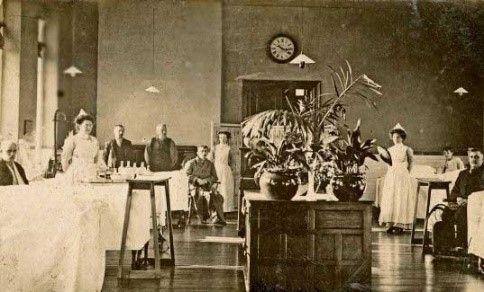Spanish Flu Ashton-under-Lyne

The last Pandemic to hit the town of Ashton under Lyne was Spanish Flu, a virus believed to be a strain of H1N1. Something we are all familiar with over the past few years and will probably see again in future years. What is ultimately surprising, is the fact that when the illness came to the town in 1918, it was dismissed. This was even though housing for the working class was some of the worst in Britain. As a member of the local clergy put it, an English man’s home is his castle; but in Ashton, this amounted to two leaky rooms, housing a family of seven.
Spanish Flu and Hot Slops
When you add to this, very poor sanitation you have a recipe for disaster for the working-class people of the town. The Spanish flu in Ashton under Lyne started during the pandemic of 1918 which killed between 20 and 50 million people worldwide; and 228,000 in Great Britain. It was not taken seriously by the area’s Medical Officer of Health, he believed that the normal rules applied. People with a fever were told to confine themselves to bed and take an aperitif (laxative). While at the same time living on a diet of hot slops, this being unappetising wet food or soup. Probably the best way to describe slops in a modern sense is what we now feed to pigs.
Other advice from Ashton’s leading medical man on Spanish Flu included more sensibly keeping a clean home, but also ensuring that children got plenty of fresh air. Sadly for a small proportion of the local population, this did not work; and twenty-four people died from mainly pneumonia after succumbing to the Spanish Flu. An event that maybe prevented further deaths in the town was the fact that at its height it was wakes week in Ashton under Lyne. So for those that could afford it, the possibility of a holiday was on the table as an; escape from the doom and gloom.
A Wakes Week Escape
History records that at the start of Wakes Week in July 1918, over 2000 people boarded special trains from Ashton-under-Lyne’s Charlestown Station. Then headed off for Southport or Blackpool for a week’s holiday. Oddly enough Southport is still one of those destinations you can get a direct train to in 2020.
After this exodus from the town, Spanish Flu abated and life returned to normal for the folk of this once-industrial giant. A week staying in guest houses and hotels with better sanitation than was the norm locally; may have done the trick. Although our town’s Medical Officer believed some heavy rain would prevent the Spanish Flu from taking hold locally; he did get his wish.
Moving on and over a century later another pandemic is upon us and although not as dangerous as Spanish Flu; nevertheless, we should listen to the advice of our leading experts. The least you can say is the fact they are not going to advise us to eat slops, although if your appetite is a bit poor; soup is always a good option. So far Tameside has only seen one death at the time of writing this piece, a resident from our neighbouring town of Stalybridge. We hope that our entire community gets through this outbreak and we don’t repeat the tragedy of 1918 and lose anyone else.
We must thank the Tameside Image Archive for providing us with more historical images of our local area and recommend a visit to their fascinating website; please follow the link.
Register For An Account
Save & manage your details, access invoices, and enjoy a quicker shopping experience!
